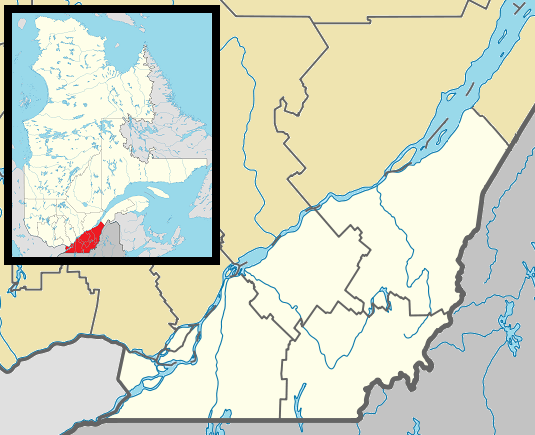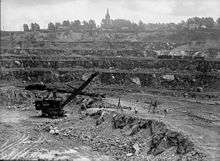Asbestos, Quebec
Asbestos is a town in the Estrie (Eastern Townships) region of southeastern Quebec, Canada on the Nicolet River.[4] Asbestos is the seat of Les Sources Regional County Municipality, formerly known as the Asbestos Regional County Municipality. The town covers an area of 29.67 square kilometres (11.5 sq mi), including land acquired due to the merger of the City of Asbestos with the Municipality of Trois-Lacs on December 8, 1999.
Asbestos, Quebec | |
|---|---|
| Asbestos | |
 | |
 Location within Les Sources RCM. | |
 Asbestos, Quebec Location in southern Quebec. | |
| Coordinates: 45°46′N 71°56′W[1] | |
| Country | Canada |
| Province | Quebec |
| Region | Estrie |
| RCM | Les Sources |
| Constituted | December 8, 1999 |
| Government | |
| • Mayor | Hugues Grimard |
| • Federal riding | Richmond—Arthabaska |
| • Prov. riding | Richmond |
| Area | |
| • Town | 31.70 km2 (12.24 sq mi) |
| • Land | 29.67 km2 (11.46 sq mi) |
| Population (2011)[3] | |
| • Town | 7,096 |
| • Density | 239.1/km2 (619/sq mi) |
| • Urban | 7,017 |
| • Pop 2006-2011 | |
| Time zone | UTC−5 (EST) |
| • Summer (DST) | UTC−4 (EDT) |
| Postal code(s) | J1T |
| Area code(s) | 819 |
| Highways | |
| Website | www |
At the 2011 census, 7,096 people resided in Asbestos. It is situated in the centre of a square formed by the cities of Drummondville, Sherbrooke and Victoriaville, and the Nicolet River to the north. It is the site of the Jeffrey mine, until recently the world's largest asbestos mine,[5] which has long been the town's largest employer, and of the now-closed Magnola magnesium refinery. It was the site of the famous 1949 Asbestos Strike.
History
During the 1960s the town was thriving and it could afford to expand and invest in its infrastructure and artistic patrimony. It provided itself with a new modern town-hall whose main hallway was adorned with a grand mural by the artist Denis Juneau, as well as some ceramic pieces in the church by the famed ceramist Claude Vermette.

In late 2011, Canada's two remaining asbestos mines (both in the Province of Quebec), Lac d'Amiante du Canada and the Jeffrey mine, halted operations.[6] In June 2012, a $58 million loan was promised by the Quebec government to restart and operate the Jeffrey mine for the next 20 years.[7] In September 2012, before the loan funds were delivered, the Parti Québécois defeated the Quebec Liberal Party in the Quebec provincial election. The Parti Québécois followed through with an election promise to halt asbestos mining and to cancel the $58 million loan, and put funding toward economic diversification in the area.[8][9]
At various times since the decline of asbestos mining, residents and politicians in the area have proposed changing the town's name due to its negative connotations;[10] however, past proposals often failed, with people involved in the debate noting that because the town is predominantly francophone and the mineral is referred to as amiante rather than asbestos in French, its residents do not associate the town's name with the stigma around the mineral.[11] A name change plan was approved by the municipal council in November 2019 and is set to take effect in 2020, with the new name chosen by a public poll.[12]
Demographics
Population
| Canada census – Asbestos, Quebec community profile | |||
|---|---|---|---|
| 2011 | 2006 | ||
| Population: | 7,096 (+4.1% from 2006) | 6,819 (+3.6% from 2001) | |
| Land area: | 29.67 km2 (11.46 sq mi) | 29.67 km2 (11.46 sq mi) | |
| Population density: | 239.1/km2 (619/sq mi) | 229.8/km2 (595/sq mi) | |
| Median age: | 51.1 (M: 48.4, F: 53.5) | 49.5 (M: 48.0, F: 51.0) | |
| Total private dwellings: | 3,467 | 3,429 | |
| Median household income: | $36,994 | $36,678 | |
| Notes: Population in 1996: 6,793[13] (+4.7% from 1991) - Population in 1991: 6,487[13] Includes corrections and updates for 1996. – References: 2011[14] 2006[15] earlier[16] | |||
Language
| Canada Census Mother Tongue - Asbestos, Quebec[17] | ||||||||||||||||||
|---|---|---|---|---|---|---|---|---|---|---|---|---|---|---|---|---|---|---|
| Census | Total | French |
English |
French & English |
Other | |||||||||||||
| Year | Responses | Count | Trend | Pop % | Count | Trend | Pop % | Count | Trend | Pop % | Count | Trend | Pop % | |||||
| 2011 | 6,955 |
6,775 | 97.41% | 115 | 1.65% | 40 | 0.58% | 25 | 0.36% | |||||||||
| 2006 | 6,660 |
6,460 | 97.00% | 80 | 1.20% | 25 | 0.38% | 95 | 1.43% | |||||||||
| 2001 | 6,435 |
6,325 | 98.29% | 90 | 1.40% | 10 | 0.16% | 10 | 0.16% | |||||||||
| 1996 | 6,095 |
5,980 | n/a | 98.11% | 85 | n/a | 1.39% | 0 | n/a | 0.00% | 30 | n/a | 0.49% | |||||
See also
- List of cities in Quebec
- Asbest, similarly named town in Sverdlovsk Oblast, Russia
- Chrysotile
References
- Reference number 2261 of the Commission de toponymie du Québec (in French)
- Geographic code 40043 in the official Répertoire des municipalités (in French)
- "(Code 2440043) Census Profile". 2011 census. Statistics Canada. 2012.
- "Asbestos" in The New Encyclopædia Britannica. Chicago: Encyclopædia Britannica Inc., 15th edn., 1992, Vol. 1, p. 613.
- Society for Mining, Metallurgy, and Exploration (U.S.) (March 5, 2006). Industrial minerals & rocks: commodities, markets, and uses. p. 196. ISBN 978-0-87335-233-8.CS1 maint: multiple names: authors list (link)
- "Asbestos mining stops for first time in 130 years". Retrieved February 6, 2017.
- "Asbestos mine reboot with Quebec cash sparks criticism". April 14, 2014. Retrieved February 6, 2017.
- Quebec Budget: Finance Minister Nicolas Marceau tightens spending, levies new taxes Archived November 29, 2012, at the Wayback Machine
- "Canada won't oppose asbestos limits". Retrieved February 6, 2017.
- "Five years after asbestos mine closure, Quebec town seeks new identity". The Globe and Mail, August 25, 2016.
- Amy Luft, "Tired of being linked to toxic substance, the Quebec town of Asbestos is changing its name". CTV News Montreal, November 27, 2019.
- Olson, Isaac (November 27, 2019). "Town of Asbestos, Que., changing its name". CBC News. Retrieved November 28, 2019.
- "Electronic Area Profiles". Canada 1996 Census. Statistics Canada. Retrieved May 11, 2013.
- "2011 Community Profiles". 2011 Canadian Census. Statistics Canada. July 5, 2013. Retrieved January 28, 2014.
- "2006 Community Profiles". 2006 Canadian Census. Statistics Canada. March 30, 2011. Retrieved August 18, 2011.
- "2001 Community Profiles". 2001 Canadian Census. Statistics Canada. February 17, 2012.
- Statistics Canada: 1996, 2001, 2006, 2011 census
External links
| Wikimedia Commons has media related to Asbestos, Quebec. |